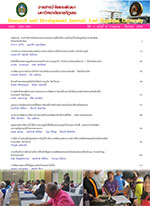แนวทางการพัฒนาคุณภาพชีวิตผู้สูงอายุจังหวัดเลยอย่างยั่งยืน
Keywords:
คุณภาพชีวิต, ผู้สูงอายุ, คุณภาพชีวิตผู้สูงอายุจังหวัดเลย, life quality, aging, Loei provinceAbstract
งานวิจัยครั้งนี้มีวัตถุประสงค์เพื่อ 1) ศึกษารูปแบบการดำเนินชีวิต 2) ศึกษาองค์ประกอบคุณภาพชีวิต และ 3) หาแนวทางพัฒนาคุณภาพชีวิตของผู้สูงอายุ จังหวัดเลยอย่างยั่งยืน ทาการศึกษาในพื้นที่เทศบาลเมืองเลย จังหวัดเลย ใช้แบบสัมภาษณ์แบบมีโครงสร้างและไม่มีโครงสร้างเป็นเครื่องมือในการเก็บรวบรวมข้อมูล ข้อมูลที่ได้จากแบบสัมภาษณ์แบบมีโครงสร้างวิเคราะห์โดยใช้ค่าสถิติ ร้อยละ ค่าเฉลี่ย และส่วนเบี่ยงเบนมาตรฐาน นำเสนอข้อมูลในรูปตารางประกอบคำบรรยาย ข้อมูลที่ได้จากแบบสัมภาษณ์แบบไม่มีโครงสร้าง วิเคราะห์โดยการวิเคราะห์เนื้อหา นำเสนอข้อมูลโดยวิธีพรรณนาเชิงวิเคราะห์ ผลการวิจัยพบว่า1. รูปแบบการดำเนินชีวิตผู้สูงอายุจังหวัดเลยแบ่งอออกเป็น 3 กลุ่ม ได้แก่ 1) กลุ่มลูกหลานพึ่งพา ผู้สูงอายุกลุ่มนี้สามารถแบ่งเบาภาระของลูกหลานเกี่ยวกับกิจวัตรประจำวันของครอบครัวได้ มีสัมพันธภาพกับเพื่อนบ้านหรือเพื่อนในวัยเดียวกันเป็นอย่างดี 2) กลุ่มพึ่งพาลูกหลาน ผู้สูงอายุกลุ่มนี้ไม่มีส่วนร่วมในกิจกรรมที่เป็นภารกิจประจำวันของครอบครัว มีสุขภาพไม่แข็งแรง ทำหน้าที่เป็นผู้เฝ้าบ้านให้ลูกหลาน ไม่สามารถเดินทางไปไหนมาไหนตามลำพังได้ มีสัมพันธภาพกับเพื่อนบ้านหรือเพื่อนในวัยเดียวกันน้อย และ 3) กลุ่มพึ่งพาตนเอง ส่วนใหญ่ประกอบอาชีพหลักคือค้าขาย หรือรับจ้าง มีสัมพันธภาพกับเพื่อนบ้านน้อย แต่มีสัมพันธภาพกับชุมชนค่อนข้างมาก จากการไปร่วมกิจกรรมทางศาสนาที่วัดในวันพระและวันสำคัญทางศาสนา
2. องค์ประกอบคุณภาพชีวิตของผู้สูงอายุ จังหวัดเลย แบ่งออกเป็น 5 ด้าน ประกอบด้วย 1) ด้านครอบครัว พบว่าผู้สูงอายุและครอบครัวมีการปรึกษาหารือกันอยู่เสมอ คิดเป็นร้อยละ 95.50 มีส่วนร่วมในการตัดสินใจ คิดเป็นร้อยละ 94.50 2) ด้านสุขภาพ พบว่าผู้สูงอายุมีความสามารถทางกาย คิดเป็นร้อยละ 90.00 ไม่บริโภคอาหารรสจัด คิดเป็นร้อยละ 63.80 ไม่สูบบุหรี่เลย คิดเป็นร้อยละ 94.30 ไม่ดื่มเครื่องดื่มแอลกอฮอล์เลย คิดเป็นร้อยละ 89.00 มีโรคประจำตัว คิดเป็นร้อยละ 56.80 ใช้สิทธิ์บัตรทองผู้สูงอายุในการรักษาพยาบาล คิดเป็นร้อยละ 53.80 3) ด้านความมั่นคงทางเศรษฐกิจ ผู้สูงอายุมีรายได้ต่ำกว่า 10,001 บาทต่อปี คิดเป็นร้อยละ 39.80 ส่วนใหญ่มีรายได้ต่อปีพอเพียง ไม่เป็นหนี้ คิดเป็นร้อยละ 61.30 4) ด้านมาตรฐานที่อยู่อาศัยและสภาพแวดล้อม ผู้สูงอายุอยู่อาศัยในบ้านที่มีลักษณะมั่นคงถาวร คิดเป็นร้อยละ 95.50 มีน้ำใช้พอเพียงตลอดปี คิดเป็นร้อยละ 99.80 อยู่อาศัยในสภาพแวดล้อมที่ไม่ประสบปัญหาเลยด้านเสียงดัง ควัน กลิ่น ฝุ่น น้ำเน่าเสีย ขยะ ของเสีย ยุงและแมลง คิดเป็นร้อยละ 49.00 5) ด้านการได้รับการสนับสนุนทางสังคม เมื่อเดือดร้อนจะมีหน่วยงานหรือคนในชุมชนมาช่วยเหลือคิดเป็นร้อยละ 91.80 และจากการศึกษายังพบว่าผู้สูงอายุจังหวัดเลย มีความรู้สึกเกี่ยวกับชีวิตความเป็นอยู่โดยภาพรวมอยู่ในระดับปานกลาง หากพิจารณาเป็นรายข้อพบว่าผู้สูงอายุมีความพึงพอใจกับสภาพที่อยู่อาศัย รู้สึกว่าชีวิตมีความหมายมีความภาคภูมิใจในตนเอง และพึงพอใจกับการได้รับบริการจากโรงพยาบาล สถานีอนามัย สถานบริการสุขภาพ พึงพอใจเกี่ยวกับสุขภาพของตนเอง และมีความปลอดภัยในชีวิตและทรัพย์สินอยู่ในระดับมาก ส่วนความรู้สึกไม่ดี เช่น หดหู่ ผิดหวัง วิตกกังวล ซึมเศร้า มีความพึงพอใจอยู่ในระดับน้อย
3. แนวทางการพัฒนาคุณภาพชีวิตของผู้สูงอายุ จังหวัดเลยอย่างยั่งยืน มีกระบวนการในการค้นหาคือ ศึกษาบริบทการพัฒนาคุณภาพชีวิตของผู้สูงอายุจังหวัดเลยในอดีต และศึกษาจากชมรมผู้สูงอายุในจังหวัดเลย ที่ประสบผลสำเร็จ สรุปข้อเสนอแนะแนวทางการพัฒนาคุณภาพชีวิตผู้สูงอายุจังหวัดเลย อย่างยั่งยืนดังนี้ 1) ค้นหาผู้นำของแต่ละชุมชนที่มีจิตอาสา มีความพร้อมในการดำเนินงาน 2) ใช้หลักการมีส่วนร่วมในการดำเนินงาน 3) จัดตั้งคณะกรรมการดำเนินงานอย่างเป็นรูปธรรม มอบหมายภารกิจหน้าที่ตามความพร้อมของแต่ละบุคคล 4) สร้างเครือข่ายกับชุมชนที่มีความต้องการพัฒนาคุณภาพชีวิตผู้สูงอายุ 5) สร้างเครือข่ายความร่วมมือ และการมีส่วนร่วมกับหน่วยงานที่เกี่ยวข้องในพื้นที่ และ 6) แสวงหาทุนสนับสนุนจากหน่วยงานต่ำงๆ ทั้งภาครัฐและเอกชน
Sustainable life quality development of aging in Loei province
The purposes of this research were 1) to study the pattern of living life, 2) to study aspects of life quality, and 3) to find the guidelines for sustainable life quality development of Aging in Loei. The study was carried out in Maung Loei municipality, Loei province. Structured and non-structured interview forms were used as tools to collect the data. Data gained from structured interview form were analyzed with percentage, mean, and standard deviation, and presented in the form of tables with descriptions. Data gained from non-structured interview form were analyzed with descriptive analysis, and presented in the form of descriptive method.
The finding were as the followings;
1. Patterns of living life of the aging were divided into 3 groups; 1) the group relied by children, this group of Aging could help their children with daily family chores, the group had good relationship with neighbors and same age people, 2) the group relied on children, this group of people did not have daily activities with family, they were not healthy, and their duty was the house watcher for children, they could not travel by themselves, and this group did not have good relationship with neighbors and the same age people, 3) the group relied on themselves, mostly, their careers were venders or contractors, they had less relationship with neighbors but they had good relationship with communities from the participation in religious activities in Buddhist holy days and other religious holidays.
2. The aspects of life quality of aging in Loei province were classified into 5 items; 1) family, the study found that aging and family always had discussion among themselves rated at 95.50 percent, they had participation in family decision rated at 94.50 percent, 2) health, the study found that the aging had physical ability rated at 90.00 percent, they did not intake strong-flavored food rated at 63.80 percent, they did not smoke rated at 94.30 percent, they did not drink alcohol rated at 89.00 percent, they had congenital disease rated at 56.80 percent, they used governmental gold card of aging for healthcare service rated at 53.80 percent, 3) economic stability, aging with an income less than 10,001 baht per year rated at 39.80 percent, mostly, they had enough income and did not have debt rated at 61.30 percent, 4) the standard of accommodation and environment, they lived in a stable house rated at 95.50 percent, the water was sufficient through the year rated at 99.80 percent, they lived in place without the problems of noise, smoke, smell, dust, polluted water, mosquito, and bugs rated at 49.00 5) social support, when they afflicted, there were organization or people in the community gave them help rated at 91.80 percent, and from the study, it showed that the aging in Loei province perceived their life quality in general at a moderate level, and when each item was considered, it showed that they were satisfied with the condition of living place, the meaningfulness of life, the pride of themselves, and they were satisfied with the services of the hospital, the health promotion hospital, health service center, they were satisfied with their health, and the safety of life and belongings at a high level, but for the feelings such as depression, disappointment, anxiousness, and sadness were at low level.
3. The guidelines for sustainable life quality development of aging in Loei province, the process in finding was the study of context for life quality development in the past, and the study of successful aging club in Loei province, and the conclusion of suggestions and guidelines for sustainable life quality development of aging in Loei province were 1) to find the community leaders who have service mind and are ready for the activities, 2) to use participation principle, 3) to appoint working committee concretely and give them duties according to each person readiness, 4) to build a community network for life quality development of aging, 5) to build collaboration network and cooperation with local organizations, and 6) to seek for fund from both public and private organizations.
Downloads
How to Cite
Issue
Section
License
ข้อความที่ปรากฎในวารสารฉบับนี้เป็นความคิดเห็นของผู้เขียนแต่ละท่าน สถาบันวิจัยและพัฒนา มหาวิทยาลัยราชภัฏเลย และกองบรรณาธิการ ไม่จำเป็นต้องเห็นด้วยและไม่มีส่วนรับผิดชอบใดๆ
สถาบันวิจัยและพัฒนา มหาวิทยาลัยราชภัฏเลย ขอให้ผู้อ่านอ้างอิงในกรณีที่ท่านคัดลอกเนื้อหาบทความในวารสารฉบับนี้






